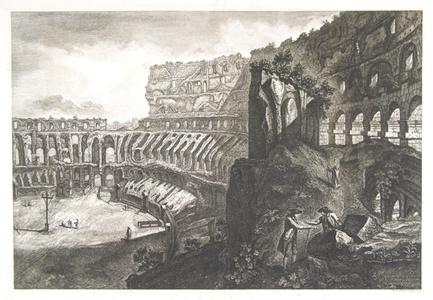| Method | Etching |
| Artist | Francesco Piranesi |
| Published | Franc. Piranesi disegno, e incise. [Paris 1788] |
| Dimensions | Image 460 x 680 mm, Plate 490 x 715 mm, Sheet 540 x 755 mm |
| Notes |
An internal view of the Colosseum, one of only two engravings completed by Francesco Piranesi for the first Paris edition of the Vedute di Roma, the other being an internal view of the Pantheon. This view of the Colosseum retains a number of later medieval and renaissance additions that have since been removed from the monument, namely the ornate colonnaded niches around the arena floor and the large crucifix at centre that has since been moved to a side entrance. The crucifix, a memorial to the Christian martyrs who died in the Roman games, was set up by a religious order that occupied the northern arches of the ruin. The colosseum was one of the most popular sights in the city of Rome for grand tourists, and demand for views of the monument was high. The overgrown ruins were dramatically picturesque, and the colosseum's history appealed as much to Christian pilgrims as it did to antiquarians. Constructed under the Flavian emperors Vespasian and Titus in the 1st century AD, the colosseum was the city's largest gladiatorial amphitheatre. The monument fell into ruin following the decline of the games after the ban on pagan festivals imposed by Theodosius at the end of the 4th century AD. It was gradually stripped of its facing marble, which was reused on many of the Renaissance-era structures in the city of Rome. The Vedute di Roma was Piranesi's most popular and best known series, celebrating the churches, monuments, ruins, bridges, fountains, and public spaces of the city of Rome. The immense popularity of the series meant that they were in constant demand, and Piranesi continued to reissue and add to the series from the 1740s until his death in 1778. The Vedute were particularly popular with British grand tourists, and had a profound effect on the British neoclassical movement. Demand was such that the series was reprinted numerous times after Piranesi's death, including two Paris editions published by his sons, Francesco and Pietro. Francesco Piranesi (c.1756-1810) was an Italian engraver, etcher and architect who mainly worked in Paris. He was the eldest son of the famous etcher Giovanni Battista Piranesi (1720-1778), under whom he studied printmaking and architecture. By 1775, Piranesi was both producing his own work and assisting with his father's. Upon the death of Giovanni Piranesi three years later, he inherited his father's publishing house and was responsible for producing most of the later editions of his prints. In 1798, Piranesi moved to Paris, where he was later employed by Napolean, to engrave classical sculpture and vase collections within France and French-occupied Italy. He also collaborated with the French artist Louis-Jean Desprez (c.1743-1804) on a series of Italian views which were sold at Piranesi's shop in Rome. Although the 1783 advertisement for the series promised forty-eight views, the series was not completed before Desprez left Rome to become Director of Scenic Decorations at the Stockholm Opera. Piranesi died in Paris from syphilis in 1810. Hind 137 i/iii (1st Paris edition), F823 f., C785. Condition: A fine impression with full margins. |
| Framing | unmounted |
| Price | £1,200.00 |
| Stock ID | 30826 |

